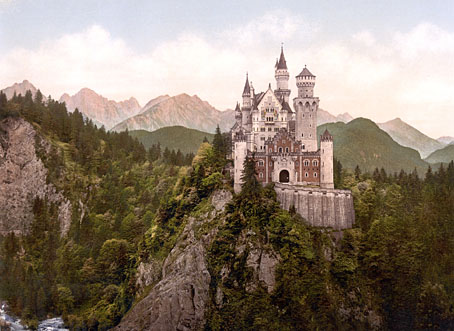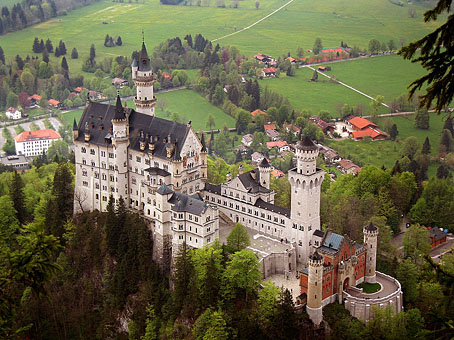This weekend’s film viewing was a DVD of Luchino Visconti’s Ludwig (1972), something I’ve seen in parts before but don’t recall ever having watched all the way through. I enjoyed it on the whole although Visconti’s “hose-piping” camera style and crash zooms are frequently annoying. Helmut Berger was very good as the tragic King of Bavaria and the subject was given additional interest by my reading earlier this year of a number of Philippe Jullian books. Ludwig II was camp enough to have interested Jullian whatever age he lived in but the way his life connects to the Symbolist period lends him a special significance. He can’t quite be described as a Symbolist monarch but his tireless support for Symbolist god Richard Wagner, and his lavish construction projects, made him a hero to Verlaine and others, who saw in the realisation of his fantasies the actions of an artist working on the grandest scale.
Of all the palaces, Schloss Neuschwanstein at Hohenschwangau is easily the most spectacular, and Wikimedia Commons has a great selection of photos of which the two here are examples. The first picture is a 1900 photochrome print originally from the Library of Congress collection and the large version makes a great desktop picture. The helicopter view shows how the apparent isolation of the castle depends on where you place the camera. Visconti’s film makes use of all the King’s buildings although we never see a full exterior shot of Neuschwanstein possibly because the castle was unfinished at the time of Ludwig’s death in 1886. While he was alive Ludwig’s palaces were regarded as outrageous extravagances by a government dismayed by his patronage of Wagner, his scandalous homosexual behaviour, and his lack of interest in the nation’s political squabbles. Over a century later, Wagner’s music receives endless performances around the world while Schloss Neuschwanstein is the most popular tourist destination in Germany. Bavaria’s wars are long forgotten yet it was the King they declared to be “mad”. There’s a moral there.
• The Neuschwanstein pool at Flickr
Previously on { feuilleton }
• Temples for Future Religions by François Garas
• Willy Pogány’s Lohengrin
• Dallamano’s Dorian Gray


